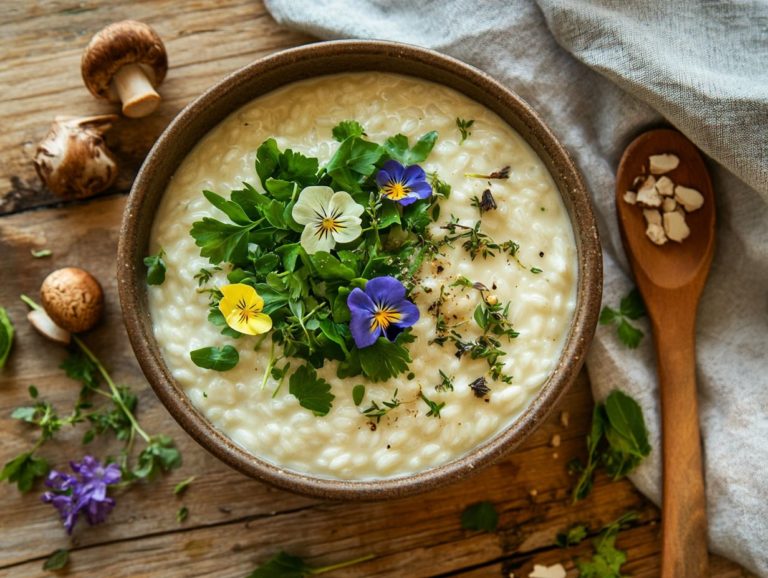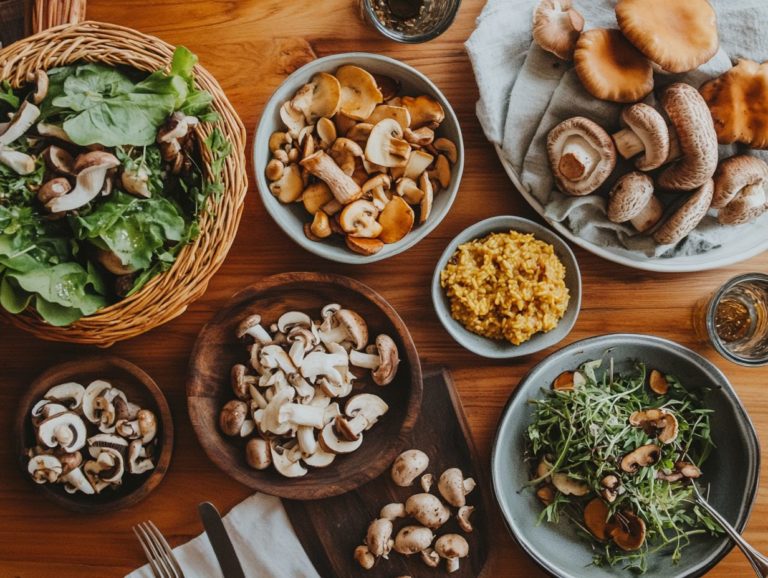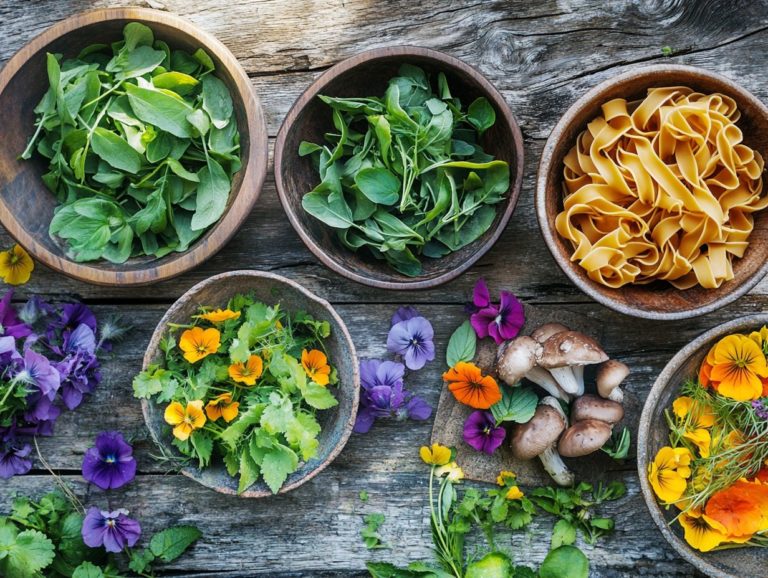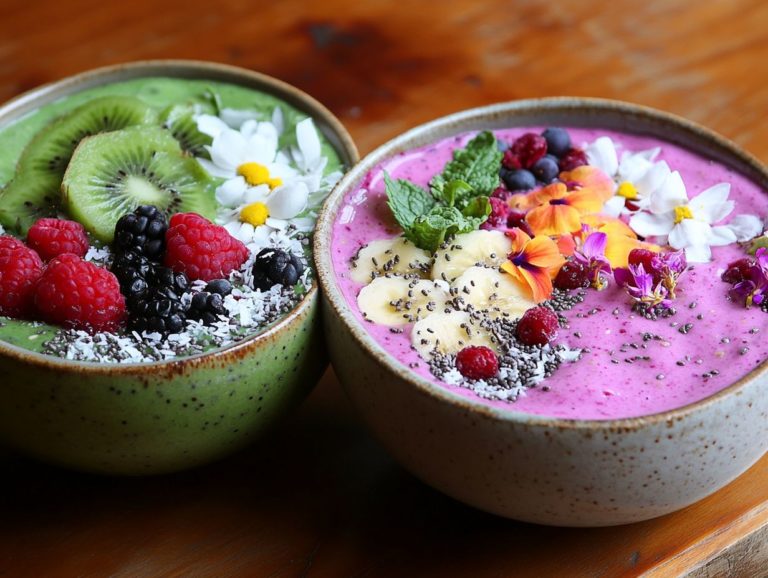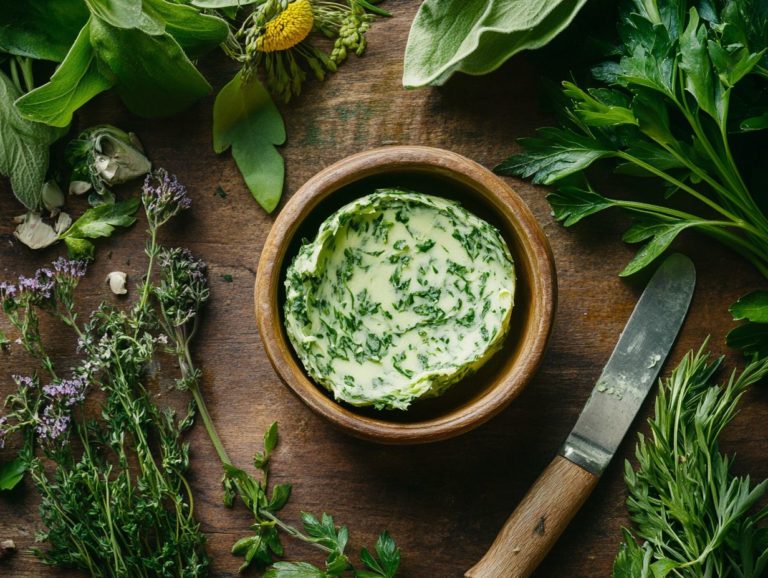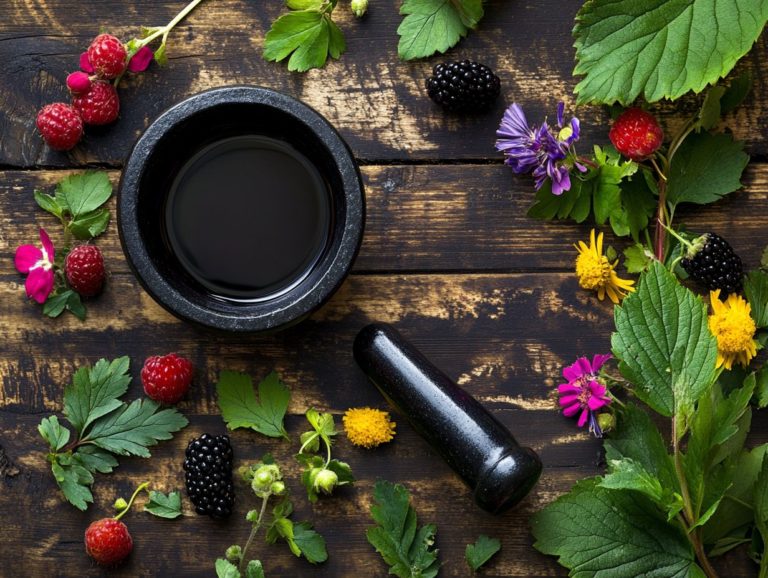5 Wild Edible Ideas for Delicious Wraps
Exploring the realm of wild edibles unveils a world brimming with culinary creativity and remarkable nutritional benefits.
This article delves into five thrilling ways to incorporate foraged ingredients into delectable wraps, catering to both adventurous eaters and health enthusiasts. Get ready to be inspired by the nutritional advantages of these natural treasures, along with enticing recipes and preparation tips that capture the essence of wild foraging.
Whether you re a seasoned forager or just dipping your toes into this exciting journey, you ll find plenty of inspiration to elevate your meals with these vibrant flavors.
Contents
- Key Takeaways:
- 1. Foraging for Wild Edibles
- 2. Nutritional Benefits of Wild Edibles
- 3. Wild Edible Wraps Recipes
- 4. Wild Edible Wraps from Around the World
- 5. Tips for Preparing and Cooking Wild Edibles
- How to Safely Identify Wild Edibles
- Frequently Asked Questions
- What are some wild edible ideas for delicious wraps?
- How do I prepare these wild edibles for my wraps?
- Are there any safety precautions I should take when foraging for wild edibles?
- What are some tips for storing and preserving these wild edibles?
- Can these wild edibles be used in other dishes besides wraps?
- Are there any health benefits to using wild edibles in wraps?
Key Takeaways:

- Incorporate wild edibles into your diet for a variety of nutritional benefits, including increased antioxidant and vitamin intake.
- Explore foraging as a fun and sustainable way to gather fresh ingredients for delicious and unique wraps.
- Create flavorful wraps with wild edibles from around the world, including Asian-inspired spring rolls and Latin American burritos.
1. Foraging for Wild Edibles
Foraging for wild edibles is not just a culinary thrill; it s a journey that deepens your connection to nature and offers insights into sustainable living. You ll discover a stunning variety of wild ingredients, such as gooseberries, elderflower, chanterelles, and wild watercress. These can be woven into your DailyWilds project for meals that are both healthy and delicious.
To embark on this adventure, first master the principles of identifying edible plants. This crucial step ensures your safety and sustainability. Understanding where these plants flourish will supercharge your foraging efforts, allowing you to uncover hidden gems right in your local environment.
Experts like Richard Mabey and Roger Phillips have paved the way in this field, sharing invaluable insights on diverse wild foods through their literature and foraging guides. You might find yourself seeking out dandelions in sun-soaked meadows or stinging nettles along riverbanks both can be harvested responsibly to maintain ecological balance.
These practices cultivate a deeper appreciation for nature’s bounty and promote a thoughtful and sustainable approach to food sourcing.
2. Nutritional Benefits of Wild Edibles
Wild edibles not only delight your palate with unique flavors, but they also deliver a nutritional boost. These foods provide balanced nutrients and plant-based proteins that can elevate your meals and enhance your overall health.
Incorporating vibrant greens and seasonal vegetables into your daily diet brings an impressive array of vitamins, minerals, and antioxidants, essential for maintaining your energy and vitality. Take dandelion greens, for instance; they re packed with calcium and vitamin A. Then there s wild garlic, which adds a flavorful kick along with heart-healthy perks.
Imagine crafting a wild greens salad drizzled with a zesty citrus vinaigrette or whipping up a stir-fry featuring tender fiddlehead ferns. These creative combinations showcase their distinctive tastes while enriching their nutritional profiles. Embrace these ingredients to craft innovative, healthy dishes that celebrate both the beauty of nature and the essence of nourishment.
3. Wild Edible Wraps Recipes
Creating wild edible wraps offers an exciting opportunity to blend unique fillings with fresh wild ingredients, vibrant veggies, and nut alternatives. The result? Simple yet delectable meals that cater to various dietary preferences, including vegan options.
These wraps serve as your canvas, fully customizable to align with your tastes and nutritional needs. Picture using wild greens like dandelion or lamb’s quarters as your base, then layering in saut ed mushrooms or fermented vegetables to add depth and flavor.
To elevate your wrap, consider incorporating a variety of savory sauces like herbed tahini or a spicy harissa. This invites you to experiment with diverse flavor profiles and textures. Embrace the freedom to mix and match ingredients; the true beauty of these wraps lies in their adaptability and your personal touch.
Share your foraging experiences or ask questions below to enhance our community of wild food enthusiasts!
4. Wild Edible Wraps from Around the World
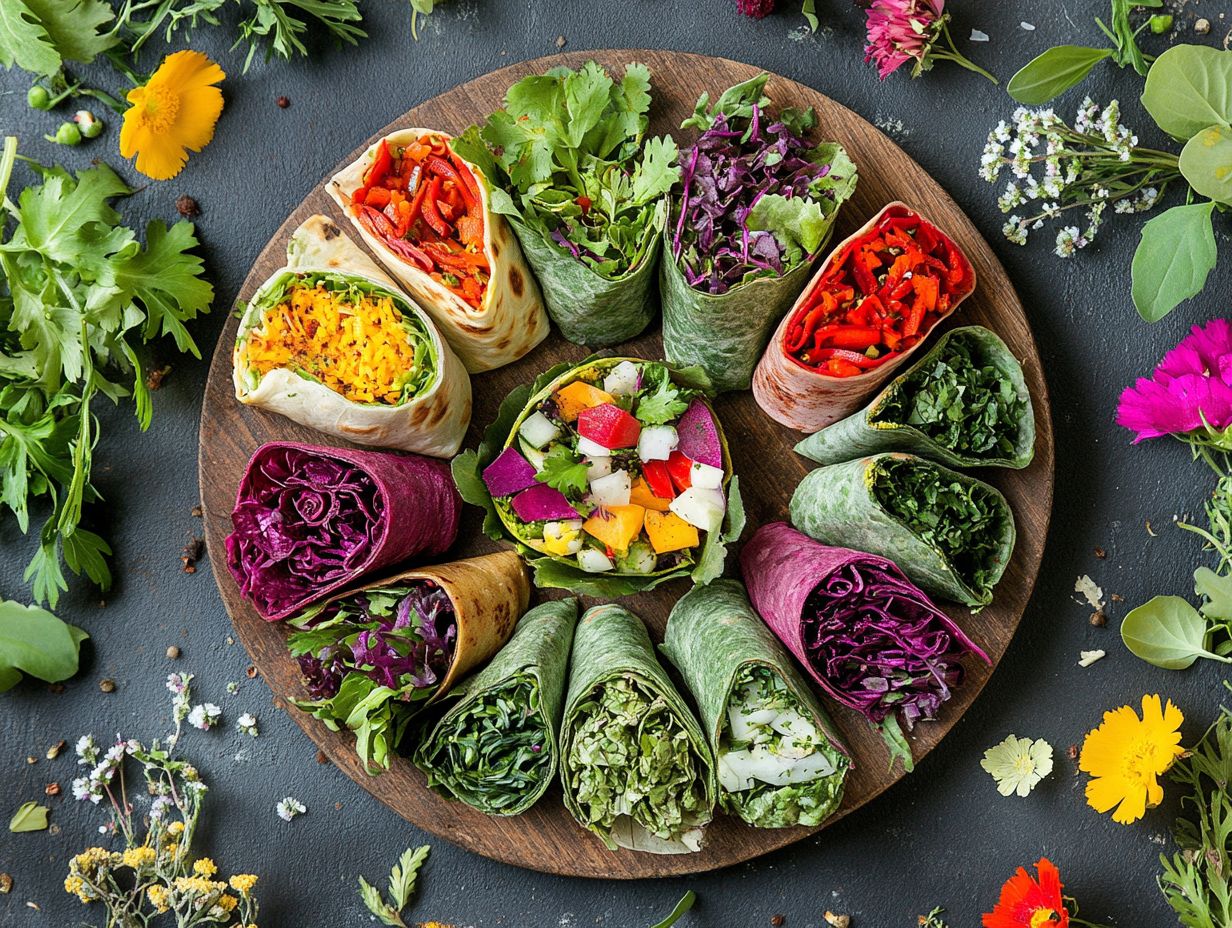
Exploring wild edible wraps from around the world opens up a delightful array of flavor combinations. These wraps showcase the rich variety of foods that global cuisine has to offer, including 5 wild edible ingredients for comfort food. They provide not just healthy lunches, but also easy meals that incorporate sustainable ingredients.
Imagine the sun-kissed shores of the Mediterranean, where grape leaves are stuffed with a tangy blend of rice and herbs. Or picture the lush forests of North America, where vibrant nettles can be transformed into nutritious alternatives. There s a treasure trove of possibilities just waiting for you!
You can make these wraps even better by fermenting or marinating them, adding layers of depth and zest. As an adventurous cook, you might experiment with local wild herbs like dandelion or chickweed. Craft cold wraps that are both refreshing and a tribute to your surroundings, creating a meaningful connection to nature and heritage.
5. Tips for Preparing and Cooking Wild Edibles
Preparing and cooking wild edibles invites you to dive into specific techniques and preservation methods. These methods enhance their natural flavors and champion food sustainability, offering you a delightful culinary exploration of unique taste profiles.
Wild edibles present a remarkable opportunity for you to embrace diverse flavors and nourish your body, often found just a stone’s throw from your kitchen door. By employing techniques like saut ing, blanching, or infusing, you can elevate the innate qualities of these foraged gems.
Preservation methods like pickling or dehydrating extend the shelf life of these treasures and help reduce kitchen waste. This fosters a circular approach to your cooking endeavors.
By integrating these practices into your daily meal preparation, you can savor seasonal delights while promoting a more sustainable lifestyle. This minimizes your reliance on store-bought produce and fully embraces the bounty that nature has to offer.
How to Safely Identify Wild Edibles
Identifying wild edibles safely is essential as a forager, especially if you re just starting out. It requires a keen understanding of the distinguishing features of various foraged ingredients. Familiarizing yourself with common wild edibles like elderflower and wild watercress is a great place to begin.
Utilizing reliable identification techniques and tools think field guides and smartphone apps can significantly elevate your foraging skills. It s crucial to learn the habitat preferences and seasonal growth patterns of these plants. This enables you to differentiate between edible species and their toxic counterparts.
For instance, getting to know characteristics such as leaf shape, flower appearance, and growth habits can save you from costly mistakes. In diverse regions, you might encounter a variety of wild edibles, including:
- Dandelions
- Chicory
- Ramps
Each one offers a unique flavor profile that can enhance your culinary creations while deepening your connection to nature.
What Are the Best Times of Year to Forage for Wild Edibles?
Understanding the best times of year to forage for wild edibles is essential for anyone interested in wild food. Different seasons present a delightful array of wild greens and seasonal vegetables at their peak freshness and flavor.
Take spring, for example; it s a prime time for gathering tender shoots and vibrant leaves like ramps and dandelions, which are bursting with nutrients. As summer unfolds, berry bushes come alive, tempting you with juicy treasures like blackberries and blueberries.
When autumn rolls around, the bounty of wild nuts and seeds becomes accessible, offering hearty snacks and fabulous additions to your meals.
Even winter has its charm; foraging enthusiasts can uncover edible roots and resilient greens that thrive beneath the frost. By knowing when to seek out specific plants, you can savor the natural variety while deepening your appreciation for the seasonal cycles in nature.
What Are the Most Common Types of Wild Edibles?
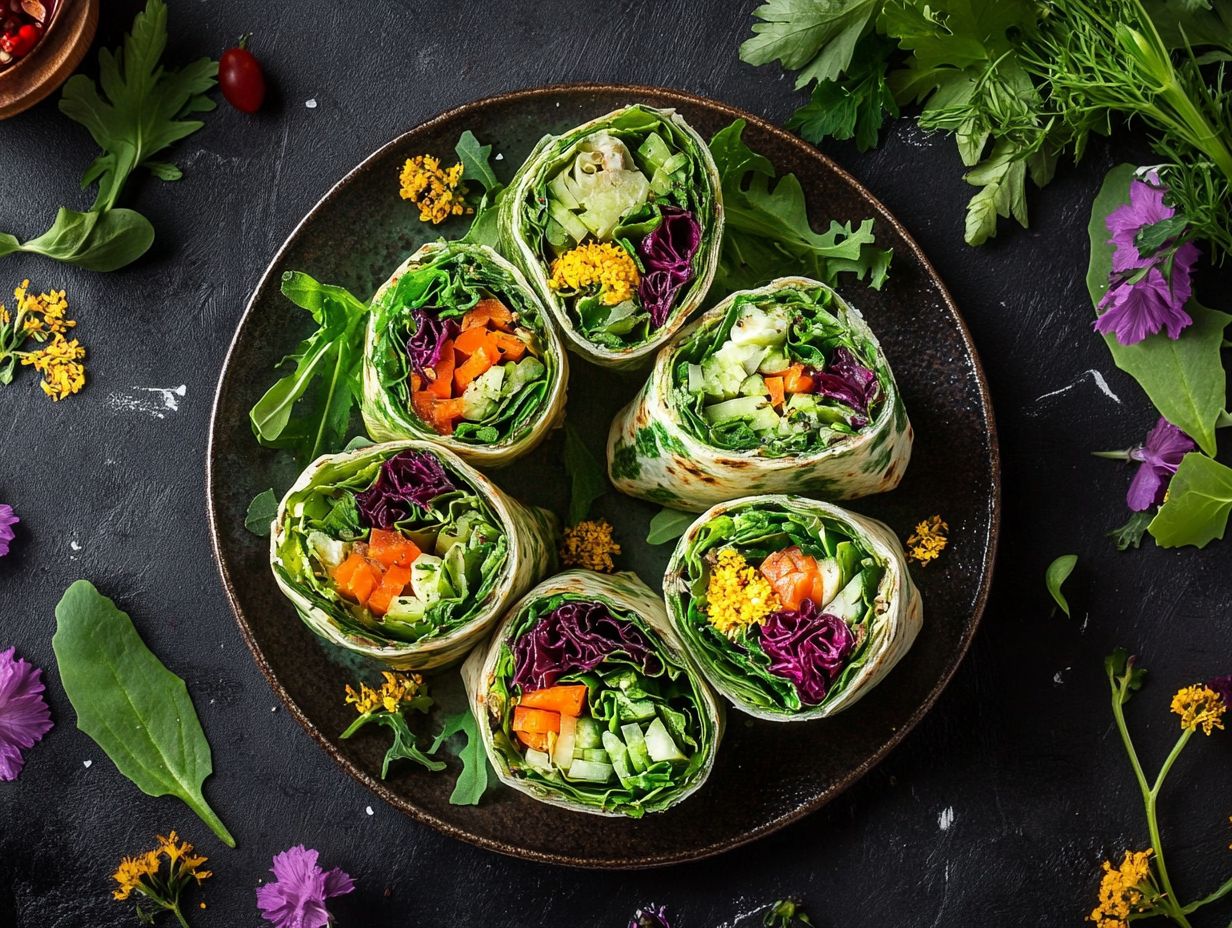
The world of wild food offers you a remarkable selection of common wild edibles. These include wild plants that elevate flavor combinations and enhance a variety of foraged dishes.
Take dandelion greens, for example. They re not just nutritious but also pack a peppery punch, making them perfect for salads or saut ing as a vibrant side dish.
Then there s garlic mustard, a delightful find that brings a mild garlic flavor to your pestos or soups.
Blueberries, with their striking color, are nature s sweet snacks, ideal for munching or using in delectable pie fillings. And don t overlook wild purslane; its refreshing taste adds a zesty crunch to your salads.
Each of these edibles boasts unique characteristics and culinary possibilities. They invite you to embrace the thrill of foraging and expand your cooking skills.
How Can Wild Edibles Be Used in Other Dishes Besides Wraps?
Wild edibles can be woven into a myriad of dishes, inviting you to a fun way to explore new cooking ideas that unveil new flavor profiles.
Imagine adding tender dandelion greens to your fresh salads; their pleasant bitterness can be exquisitely balanced with a splash of citrus vinaigrette. This creates a delightful dance of flavors.
If you’re in the mood for something warm, consider incorporating wild garlic into a simple soup. It infuses the dish with a rich, garlicky aroma that lingers on the palate.
Wild berry compote can be your perfect sauce for drizzling over grilled meats or desserts. It blends sweet and savory in a surprising yet harmonious way.
These vibrant ingredients not only elevate your meals but also deepen your connection to the great outdoors.
What Are the Different Types of Wraps That Can Be Made with Wild Edibles?
There are countless ways to create wraps using wild edibles, and you can explore using wild edibles in breakfast for some delicious ideas. Each option highlights the versatility and flavor of foraged foods.
Imagine tender dandelion greens or vibrant purslane wrapped around your favorite fillings, capturing the essence of nature’s bounty.
Pairing wild leeks with smoked salmon offers a delightful contrast. Combining stinging nettles with goat cheese introduces a creamy richness that elevates your dish.
Incorporating seasonal herbs like wild garlic can further enhance the taste, turning each bite into a refreshing experience.
Whether you lean towards a hearty wrap packed with protein-rich wild mushrooms or a light, zesty version drizzled with citrus-infused dressing, the possibilities for crafting exciting and nutritious meals are truly endless.
How Can One Incorporate Wild Edibles into Their Diet?
Incorporating wild edibles into your diet is a thrilling experience! It offers vibrant flavors and nourishing meals that align with a sustainable lifestyle.
To fully embrace these unique offerings, begin by foraging or sourcing seasonal plants from a trusted supplier. Experimenting with wild greens like dandelion or chickweed can infuse a delicious twist into your salads or sandwiches.
Consider crafting a savory pesto with garlic mustard. This pairs beautifully with pasta or serves as a flavorful topping for grilled meats.
For snacking, try dehydrating wild fruits or brewing herbal teas to savor throughout the day.
Enhance your favorite recipes by substituting traditional ingredients with their wild counterparts. For example, add nettles to soups or incorporate acorns into baked goods. This not only elevates your dish but also celebrates the rich bounty nature has to offer.
Frequently Asked Questions
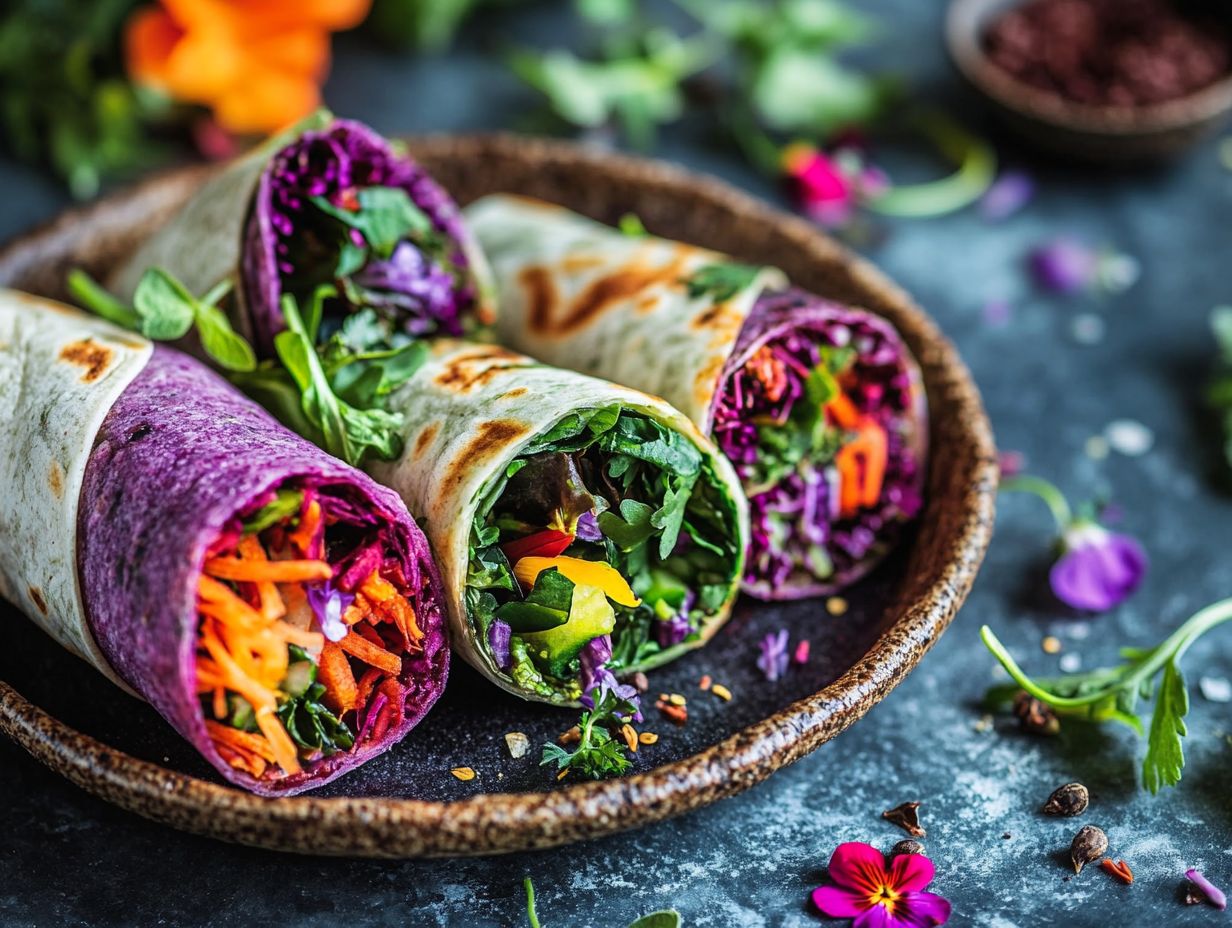
What are some wild edible ideas for delicious wraps?
- Dandelion Greens: These leafy greens are a nutritious and slightly bitter addition to your wraps. They are high in vitamins A and C and can be found in most fields and backyards.
- Purslane: This succulent plant has a tangy flavor and is packed with omega-3 fatty acids. You can find it in your garden or in cracks of sidewalks.
- Nasturtium Leaves: These vibrant, peppery leaves are a great addition to wraps and are high in vitamin C. Look for them in many flower gardens.
- Chickweed: With a mild, slightly sweet taste, this plant makes a great substitute for lettuce in wraps. You can find it in open fields or near water sources.
- Wild Garlic: The small bulbs and leaves of wild garlic add a delicious, garlicky kick to your wraps. Look for them in wooded areas or near streams.
How do I prepare these wild edibles for my wraps?
- Wash and dry the plants thoroughly before adding them to your wraps.
- Tear or chop the leaves and stems into small, manageable pieces.
- If they have a bitter or spicy taste, blanch them in boiling water for a few seconds to mellow out the flavor.
- Mix and match different wild edibles to create unique flavors in your wraps.
Are there any safety precautions I should take when foraging for wild edibles?
- Identify the plant correctly before eating.
- Avoid foraging near roadsides or areas that may have been sprayed with chemicals.
- Do not pick plants from private property without permission.
- If you have allergies, avoid plants that may trigger a reaction.
What are some tips for storing and preserving these wild edibles?
Store the washed and dried plants in a sealed container in the refrigerator for up to a week. Freezing is a fantastic way to enjoy these greens later blanch them for a few seconds, dry them, and then store them in a freezer-safe bag or container. To preserve them for longer, you can pickle them in vinegar or dry them in a dehydrator.
Can these wild edibles be used in other dishes besides wraps?
Yes! These wild edibles can enhance a variety of dishes such as salads, soups, stir-fries, and more. Get creative and experiment with different recipes to incorporate these nutritious plants into your meals.
Are there any health benefits to using wild edibles in wraps?
Absolutely! Wild edibles are often rich in nutrients and free of pesticides and chemicals. They are a fantastic choice for your health and the planet! Plus, foraging for wild edibles offers a great form of outdoor exercise and stress relief.
Get outside and discover the delicious world of wild edibles today!

